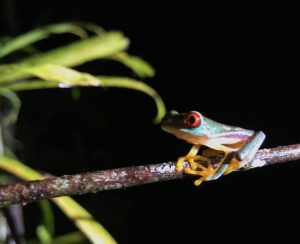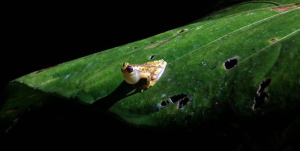
By Addison Dennard and Tommy Bui
After our stay at La Selva, we visited a biological station in the Veragua Rainforest, founded to promote research of the flora and fauna in the surrounding area. We hung out on the porch, and played ping pong and Foosball before dinner. After dinner we had a night hike with the naturalists and biologists from the station. It was not a typical hike, because we walked on the paved way back to our cabin.However, we saw an incredible amount of wildlife within the small stretch between the dining hall and our rooms. Specifically, there was an enormous diversity of amphibians. We saw red-eyed tree frogs, dink frogs, tiger frogs, and an extremely rare Lemur frog. Towards the end of the hike, there was an amphibian breeding pond that had a symphony of frog calls blaring from the water. It was safe to say, we have never seen this many frogs in our entire lives.

The next day we were shown around to the various exhibits around the biological station. Although the primary mission of the station is research, it relies on tourism to support these studies. Made by the researchers themselves, the exhibitions consisted of endemic reptiles and amphibians. There was also a butterfly museum with a butterfly garden! After lunch, we rode the tram down to the waterfall trail and the surprise, off-trail hike to the swimming hole. On the way, we saw the artificial breeding ponds that the researchers had made for the observation of tiger frogs. Later that evening, we had a lecture from the researchers about the amphibian and mammal research going on at the biological station. It was inspiring to see how much work they had put into learning more about the wildlife in the rainforest. For example, the mammal researcher would sleep during the day and be up all night to catch bats in the net he had set up over a stream; the amphibian researcher built a fake frog and made frog calls, in order to understand the territorial behavior of a certain species of frog. The research in Veragua describing these certain behavioral characteristics provides some of the only insight in the world on these animals.

After dinner, we then had an “extreme night hike” – straight down the mountainside to the stream. Again, there was a tremendous amount of wildlife. We saw sleeping toucans and sloths, along with even more frogs. While hiking in the stream, we got to see crabs, an eyelash pit viper snake, and bats. The mammal researcher even let us release the bats from the net! At the end of the hike, one of the naturalist asked us to turn off our lights and enjoy the forest in silence. He told us why it is important to learn and teach others about conservation, in order to save forests like the one that we were in. It was an extremely inspiring message and a great note to end the night on. Before we hit the road again the next morning, we went zip lining through the canopy. There were a total of 11 lines, and plenty of wildlife along the way. We even saw a sloth trying to descend the tree next to the zip line, but it slowly climbed back to its branch when it saw us. According to Amanda, these zip lines are a warm up for the one back in Monteverde.

Overall, our trip to Veragua has been one of our favorite stops. The wildlife was out of this world, and the researchers/naturalists were extremely welcoming. Before we left, one of the researchers gave us his business card, saying that we are welcome to come back to research through the University of Costa Rica and visit any time. Hopefully, some of us will take that offer up and be back with the frogs soon.
Please watch the video of our two day adventure in Veragua!
